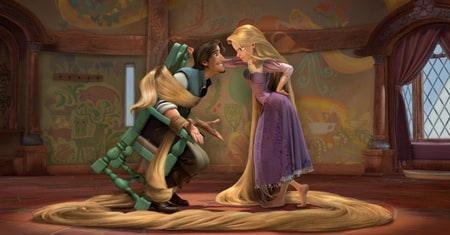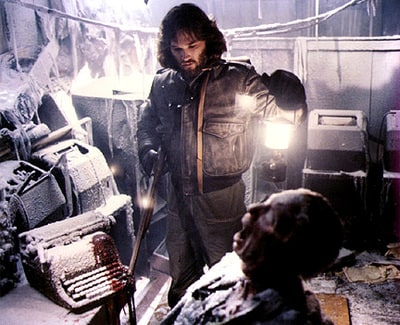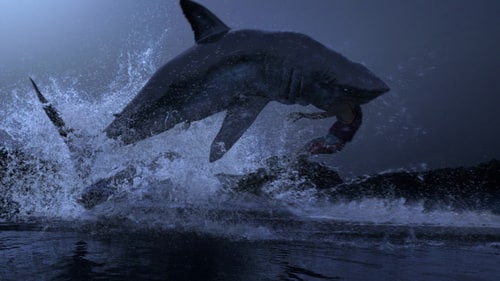Following 2009's The Princess and the Frog with another tale of romance and princesses, Tangled is Disney's 50th animated feature film. And for this prestigious occasion, the studio turned to the story of Rapunzel, which was one of few fairytales that hadn't been given a trademark overhaul by the House of Mouse. In order to appeal to as many demographics as possible, Tangled has romance, action, adventure and musical numbers...in other words, it slavishly adheres to the exact same formula that was applied to the 49 feature-length animations that Disney produced prior to it. But while this computer-generated fantasy is generic, it's nevertheless charming, amusing and adventurous.

As an infant, young Rapunzel (voiced by Moore) was stolen away from her parents by the wicked Mother Gothel (Murphy), planning to use the girl's long magical hair to retain her youthful looks. Thus, Gothel houses Rapunzel in a tower and forbids her to leave, teaching the child to fear the outside world and convincing her that she can only be safe at home. From afar she watches the nearby kingdom and is enraptured by their festivities, and yearns for nothing more than to free herself from Mother Gothel's forceful grasp to explore the outside world. Into her life soon comes local thief Flynn Rider (Levi), who stumbles upon Rapunzel's tower while on the run from both the kingdom guards and the criminal partners he double-crossed. Rapunzel is shocked by the intrusion, and only agrees to let Flynn (and his stolen treasure) go if he escorts her to the kingdom so she can witness the beautiful annual lantern show.
The big problem with Tangled is its devotion to the Disney formula. Screenwriter Dan Fogelman (Cars, Bolt) stuck to the studio's well-worn staples: a feisty princess, a dashing hero, a villainous witch, wacky animal sidekicks and jaunty musical numbers. Heck, the music was even written by Alan Menken, whose contributions to The Little Mermaid, Beauty and the Beast, Pocahontas and other titles have made him a Disney favourite. The songs, unfortunately, do not gel as well as they should have. They're enjoyable in the moment but forgettable, and their inclusion feels forced at the demand of the formula. There's a bit of tonal schizophrenia too, as directors Nathan Greno and Byron Howard tried their hardest to broaden appeal for maximum profits. The tonal juggling is not entirely slipshod, but some moments are too saccharine-coated for adult audiences while others are probably too intense for infants. The other flaw with Tangled is pacing issues; Flynn and Rapunzel's journey is admittedly lax from time to time.

But the above are the only drawbacks of what is otherwise a wholly enjoyable Disney production. The laughs are constant and satisfying, with a handful of sly one-liners (for the most part courtesy of Flynn), and some hilarious Looney Tunes-style antics featuring a stubborn white horse. Despite the formulaic structuring of Fogelman's screenplay, dialogue is surprisingly strong - the banter between Flynn and Rapunzel is sharp and witty, and the characters share good chemistry. Flynn is one of the most likeable Disney heroes in years, while Rapunzel is a genuine stunner of a princess (who knew cartoon females could look so beautiful?). Best of all, while the feature is generic and calculated, it works - the tragic moments tug on the heart, the upbeat moments make us smile, and the film leaves us with a warm and fuzzy feeling. Tangled successfully replicates that old Disney magic, allowing us to overlook any minor scripting faults.
Best of all, Tangled features some of Disney's most elegant visual craftsmanship to date. Directors Nathan Greno and Byron Howard elected a style of animation which replicates the traditional hand-drawn animation aesthetic in computer-animated 3-D, resulting in an impeccable hybrid of the old and the new. The filmmakers struck the perfect balance between realism and caricature; the CGI approach permitted a level of phenomenal detail that would be impossible to achieve with the former pen-and-ink style, while the movie's cartoonish look is also reminiscent of something like Pinocchio or The Little Mermaid. The colour palette is often lush as well, bringing about several instantly iconic images (the lantern scene is stunning), and the action beats were staged with immaculate finesse. This was Disney's most expensive movie yet, but the ridiculous $260 million price-tag has paid off.

As the young Rapunzel, Mandy Moore's vocal performance is chipper and amiable. The general aura that Moore brings to the role makes Rapunzel a truly pleasant character. Zachary Levi is also excellent as Flynn, with a completely charming line delivery befitting of the character. But it's Broadway veteran Donna Murphy who steals the show as Mother Gothel with brilliant menace and a wicked demeanour. Meanwhile, great characters actors filled out supporting roles (even the likes of Ron Perlman, Jeffrey Tambor, Richard Kiel and Brad Garrett feature here), and they all placed forth competent work. However, none of the characters are anywhere near as funny as Maximus, the silent royal horse who's rather hostile towards Flynn (and vice versa). The horse is easily the best character in the film, but it's good that his screen-time is so limited because it makes his fleeting appearances all the funnier.
Tangled may be business as usual in terms of Disney storytelling procedures, but it's surprisingly refreshing because it's not some postmodern, "hip" Shrek-style fairytale reinvention, and the comedy is free of pop culture references. With humour, heart, songs, and typical Disney-esque themes, Tangled is worthy of being Disney's 50th animated feature, and it's baffling that the movie was not even nominated for the Best Animated Movie Oscar.
7.5/10
 Login
Login
 Home
Home 183 Lists
183 Lists 1671 Reviews
1671 Reviews Collections
Collections
 3 comments,
3 comments, 































